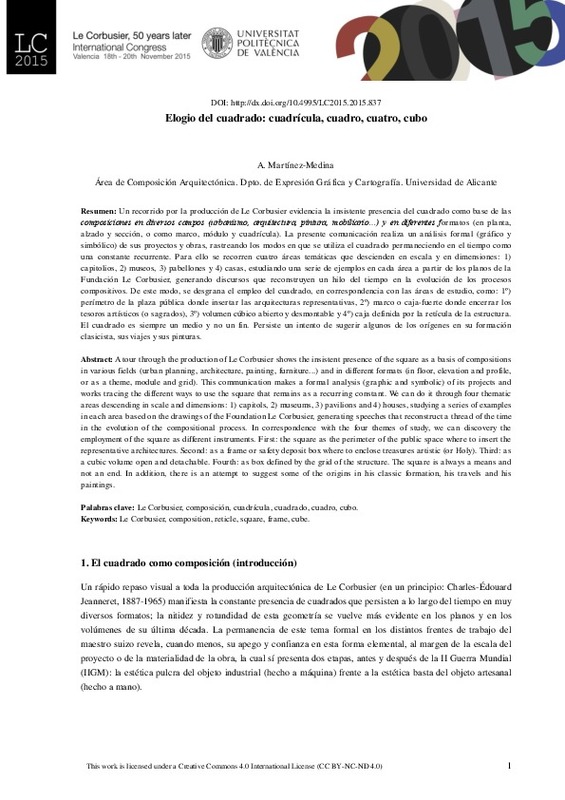|
Resumen:
|
[EN] A tour through the production of Le Corbusier shows the insistent presence of the square as a basis of compositions
in various fields (urban planning, architecture, painting, furniture...) and in different formats ...[+]
[EN] A tour through the production of Le Corbusier shows the insistent presence of the square as a basis of compositions
in various fields (urban planning, architecture, painting, furniture...) and in different formats (in floor, elevation and profile,
or as a theme, module and grid). This communication makes a formal analysis (graphic and symbolic) of its projects and
works tracing the different ways to use the square that remains as a recurring constant. We can do it through four thematic
areas descending in scale and dimensions: 1) capitols, 2) museums, 3) pavilions and 4) houses, studying a series of examples
in each area based on the drawings of the Foundation Le Corbusier, generating speeches that reconstruct a thread of the time
in the evolution of the compositional process. In correspondence with the four themes of study, we can discovery the
employment of the square as different instruments. First: the square as the perimeter of the public space where to insert the
representative architectures. Second: as a frame or safety deposit box where to enclose treasures artistic (or Holy). Third: as
a cubic volume open and detachable. Fourth: as box defined by the grid of the structure. The square is always a means and
not an end. In addition, there is an attempt to suggest some of the origins in his classic formation, his travels and his
paintings.
[-]
[ES] A tour through the production of Le Corbusier shows the insistent presence of the square as a basis of compositions
in various fields (urban planning, architecture, painting, furniture...) and in different formats ...[+]
[ES] A tour through the production of Le Corbusier shows the insistent presence of the square as a basis of compositions
in various fields (urban planning, architecture, painting, furniture...) and in different formats (in floor, elevation and profile,
or as a theme, module and grid). This communication makes a formal analysis (graphic and symbolic) of its projects and
works tracing the different ways to use the square that remains as a recurring constant. We can do it through four thematic
areas descending in scale and dimensions: 1) capitols, 2) museums, 3) pavilions and 4) houses, studying a series of examples
in each area based on the drawings of the Foundation Le Corbusier, generating speeches that reconstruct a thread of the time
in the evolution of the compositional process. In correspondence with the four themes of study, we can discovery the
employment of the square as different instruments. First: the square as the perimeter of the public space where to insert the
representative architectures. Second: as a frame or safety deposit box where to enclose treasures artistic (or Holy). Third: as
a cubic volume open and detachable. Fourth: as box defined by the grid of the structure. The square is always a means and
not an end. In addition, there is an attempt to suggest some of the origins in his classic formation, his travels and his
paintings.
[-]
|








